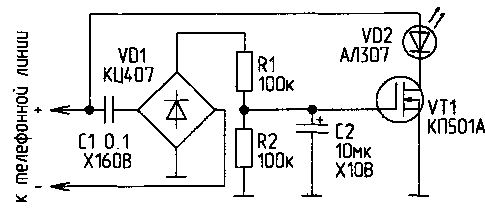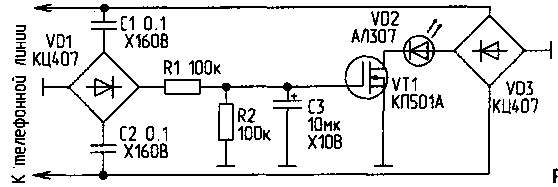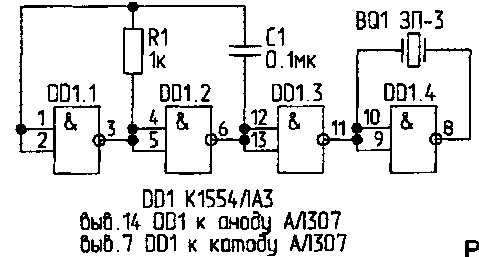
|
|
ENCYCLOPEDIA OF RADIO ELECTRONICS AND ELECTRICAL ENGINEERING Three phone locks. Encyclopedia of radio electronics and electrical engineering
Encyclopedia of radio electronics and electrical engineering / Telephony Since we are not threatened with widespread telephone installation in the near future, some of our compatriots have learned to solve their problems at the expense of their neighbors. Having connected to other people's telephone lines, they call wherever they want. Those who have been the victim of such piracy know how frustrating it is to receive unexpectedly increased phone bills. Of course, you can put a caller ID phone with line protection functions from unauthorized access. But such devices are quite expensive, and the telephone exchange requires additional payment for using them. The most optimal in this situation is the use of special locks-locks. Unlike conventional blockers [1], these devices perform the function of a kind of "barn" lock on the telephone line, making it impossible to dial the number correctly into the line, and the passage of the ringing signal. Such devices do not interfere with the normal operation of telephone exchanges. The scheme of the simplest lock is shown in fig. 1. In the initial state, the capacitor C2 is not charged, and the transistor VT1 is locked. When an alternating voltage occurs in the telephone line (dialing or calling the PBX), the voltage of the charged capacitor C2 opens the transistor VT1, and the telephone line closes for a short time.
The charge of the capacitor C2 stops, and it is discharged through the resistor R2. Transistor VT1 closes. The telephone line remains open until the next pulses. The disadvantage of such a lock is that when it is connected to a telephone line, polarity is required. The scheme presented in Fig. 2 contains more details, but is spared from the above drawback.
In life, it is not always necessary to "extinguish" the ringing signal from the PBX. More often it is required to "spoil" only dialing. The locks shown in Figs. 1 and 2 do not make such a selection. A more perfect lock is shown in Fig.3. It is powered from the telephone line through the resistor R8 and consumes no more than 0,1 mA from the line in standby mode. Zener diode VD3 - parametric voltage stabilizer. The voltage pulses that occur in the telephone line when dialing a number or when ringing from the PBX, through the cascade on the transistor VT2, are fed to the clock input C (pin 14) of the DD2 microcircuit. After five pulses, a high level appears at pin 1 of the DD2 microcircuit, the transistor VT3 opens, and the telephone line is blocked. At the same time, this high level is applied to the enable account input DD2 (pin 13) and prohibits further counting. Logic level "1" at the input of the element DD1.1 after double inversion causes the output of the element DD1.2 voltage high level. Capacitor C1 begins to slowly charge through resistor R7, and after about 1 s a high level at the input of element DD1.3 causes a single level signal to appear at the input R of the DD2 chip. The counter is reset, the transistor VT3 turns off, the circuit returns to its original state. The cascade on the transistor VT1 responds only to the ringing signal from the PBX and serves to prohibit the operation of the "lock" from the call signal. The low voltage level taken from the VT1 drain, applied to pin 6 of DD1.4, causes a high level to appear at the R input of the DD2 chip, i.e. the counter is kept in its original state. The user can disable or allow the call signal from the PBX using switch S1. Switch S2 is used to disable the operation of the entire device when the owner of the telephone line himself needs to dial a number. The only timing circuit R7, C1, VD1 performs two functions: - determines the line blocking time when the "lock" is turned on; - in standby mode, forcibly sets the counter DD2 to its original state. Chip DD1 can be replaced by K561LA7. Transistors VT1, VT2 can be with any letter - A, B, C, but the transistor VT3 - only with the letter A. The light indication of the inclusion of locks can also be supplemented with sound. Figure 4 shows a sound generator made on a 1554 series chip (similar to 74AC00N). Unlike the 561 series, the microcircuits of the above series are operational at a supply voltage of 2 V.
The piezoelectric BQ1 is connected in a bridge circuit. The generator is powered by the voltage released on the LED, i.e. the outputs "Power" and "Common" DD1 are connected to the anode and cathode of the LED in any of the lock circuits. Literature
Author: A. Mikhalevich, Minsk; Publication: N. Bolshakov, rf.atnn.ru
Artificial leather for touch emulation
15.04.2024 Petgugu Global cat litter
15.04.2024 The attractiveness of caring men
14.04.2024
▪ Apex Storage X21 AIC Adapter ▪ Transistors of the MDMESH V family ▪ Hereditary obesity is not always determined by genes ▪ Wireless BLE sensor STEVAL-BCN002V1B
▪ section of the website Audiotechnics. Article selection ▪ article Art starts with a little bit. Popular expression ▪ article Where did the first watermelons appear? Detailed answer ▪ article Technological tank handler. Standard instruction on labor protection ▪ article Lubricant used when cutting screws. Simple recipes and tips ▪ article Pencil and book. physical experiment
Home page | Library | Articles | Website map | Site Reviews www.diagram.com.ua |






 Arabic
Arabic Bengali
Bengali Chinese
Chinese English
English French
French German
German Hebrew
Hebrew Hindi
Hindi Italian
Italian Japanese
Japanese Korean
Korean Malay
Malay Polish
Polish Portuguese
Portuguese Spanish
Spanish Turkish
Turkish Ukrainian
Ukrainian Vietnamese
Vietnamese




 Leave your comment on this article:
Leave your comment on this article: